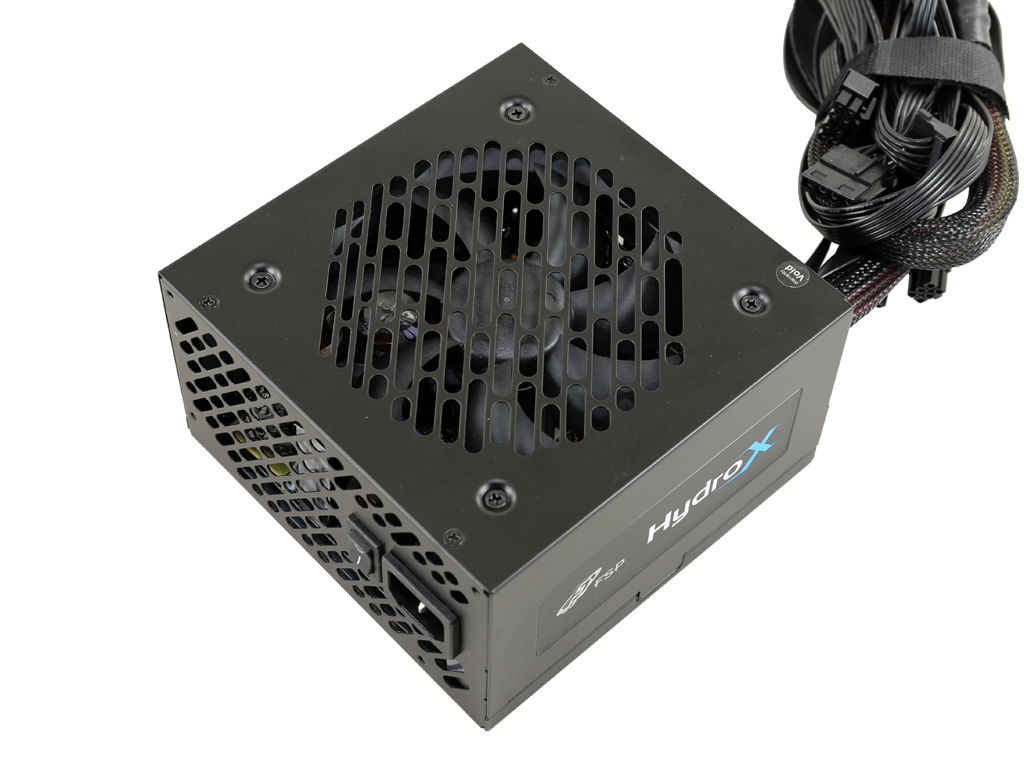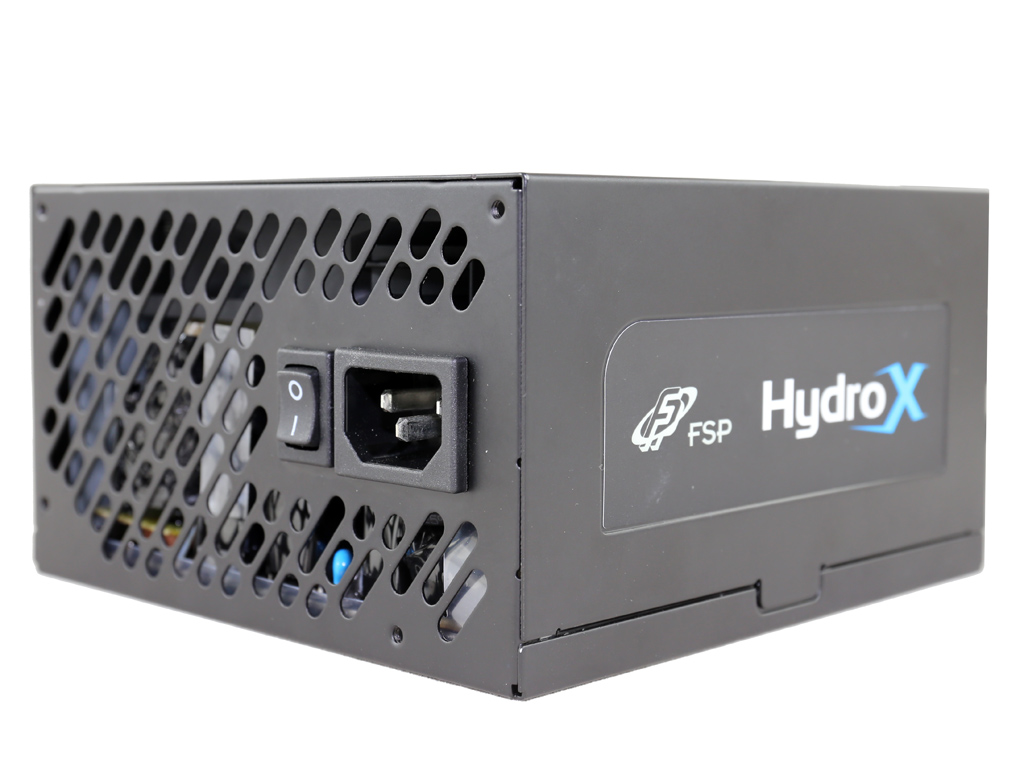Early Verdict
FSP's Hydro X 450 is a highly efficient and overall, a silent PSU geared towards systems with low energy needs. Its major downside at this time is its high MSRP, however we expect the street price to be much lower. The PSU's strong points are its increased reliability, thanks to the Japanese electrolytic capacitors, and the double ball-bearing fan. On top of that, the HGX450 comes with a five year warranty.
Pros
- +
Full power at 46 °C • Efficient • Ripple Suppression • Silent • Compact dimensions • Quality electrolytic caps • Highly efficient 5VSB rail • 2x PCIe connectors • Warranty • External design
Cons
- -
High MSRP • Hold-up time • 3.3V performance in the Advanced Transient Response tests • Non modular • The cable that holds the fan control thermistor should be longer in order to be routed better inside the PSU
Why you can trust Tom's Hardware
Introduction
FSP is trying hard to get its products into the retail market. Until now, the company was mostly focused on OEM sales, but we all know landing on store shelves is how you get your name recognized. A while ago we reviewed FSP's 650W Hydro G PSU, which left us quite satisfied with its performance. The Hydro G line is mostly enthusiast-oriented, so its prices are on the high end (although we've noticed that they have dropped here in the U.S.). Since most PSU sales are for the lower-capacity models, FSP released a more affordable line (compared to the Hydro G lineup) called Hydro X, which covers the mainstream folks who don't really care about modular cables, but do need increased reliability and good performance.
Although the Hydro X models are more affordable than the Hydro G ones, their prices aren't as low as we expected. According to official sources, the Hydro X 450W, 550W and 650W models cost $90, $100 and $110, respectively. Fortunately, MSRPs are usually much higher than street prices, so once these products hit the market, we're hoping they're more affordable. After all, the same thing happened when the Hydro G power supplies launched.

The Hydro X line currently consists of three units with capacities ranging from 450W to 650W. These PSUs lack modular cabling, though that looks like the only compromise in their design. According to FSP, we should expect high performance thanks to an advanced platform with the LLC resonant converter on the primary side and synchronous rectification of the +12V rail on the secondary side, along with DC-DC converters for the minor rails. The 5VSB circuit promises high efficiency attributable to an advanced standby controller. Plus, Japanese electrolytic and Taiwanese polymer capacitors are used in these PSUs. And finally, their cooling fans feature double ball-bearings for increased reliability.
Today, we're evaluating the smallest Hydro X PSU with 450W capacity. Should it perform well in our tests, the HGX450 would make a great little power supply for single-GPU gaming PCs. If FSP can get the price tag closer to $70, the HGX450 might even become a good deal, considering its high-quality components.
Specifications

MORE: Best Power Supplies
MORE: Power Supplies 101
MORE: How We Test Power Supplies
MORE: All Power Supply Content
All Hydro X units feature 80 PLUS Gold efficiency and are compatible with the C6 and C7 sleep states that Intel introduced with the Haswell processors. They're only rated to deliver their full power continuously at up to 40 °C, despite that the ATX spec recommends 50 °C. But this won't stop us from applying temperatures above 45 °C inside our hot-box during our tests. All necessary protection features appear to be accounted for, including over-temperature protection (OTP). The HGX450 is cooled by a double ball-bearing fan, which has a much longer lifespan than sleeve-bearing fans. FSP doesn't implement a semi-passive mode though; this could have increased the fan's useful life even more, also enabling zero noise output under light loads.
The unit's dimensions are compact, although it could have been smaller given such low capacity. FSP understandably leverages the same enclosure for its higher-capacity models to help reduce production costs. As a result, the HGX450 is 15cm deep. That's still on the low side, given that most ATX PSUs measure 16cm deep.
Get Tom's Hardware's best news and in-depth reviews, straight to your inbox.
FSP covers this model with a five-year warranty, demonstrating that, despite its modest output and lack of modular cabling, this is a high-end product. Then again, the $90 MSRP already tipped you off. But a lofty price tag puts the HGX450 in a difficult position against competing models in the same class.
Power Specifications
| Rail | 3.3V | 5V | 12V | 5VSB | -12V | |
|---|---|---|---|---|---|---|
| Max. Power | Amps | 20 | 20 | 37.5 | 2.5 | 0.3 |
| Watts | 120 | 450 | 12.5 | 3.6 | ||
| Total Max. Power (W) | 450 |
The +12V rail can deliver up to 37.5A, so it meets the needs of graphics cards in the 200-220W category. The minor rails are pretty strong with 120W max combined power, while the 5VSB rail has the typical amperage.
Cables And Connectors
| Native Cables | ||
|---|---|---|
| Description | Cable Count | Connector Count (Total) |
| ATX connector 20+4 pin (600mm) | 1 | 1 |
| 4+4 pin EPS12V (700mm) | 1 | 1 |
| 6+2 pin PCIe (500mm+100mm) | 1 | 2 |
| SATA (500mm+150mm+150mm+150mm) | 1 | 4 |
| SATA (500mm+150mm) / four-pin Molex (+100mm+100mm) / FDD (+100mm) | 1 | 2 / 2 / 1 |
The fixed cables are long enough and the number of available connectors is sufficient for this unit's capacity. The fact that the HGX450 comes with two PCIe connectors greatly enhances its usability, since it natively works with high-end cards that have two PCIe sockets. The distance between connectors is good in the single PCIe cable. However, we noticed something strange on the peripheral cables: instead of installing the four-pin Molex connectors further away from each other and the SATA plugs closer, FSP did the opposite. This isn't logical since SSDs/hard drives are usually installed close to each other, while components like case fans are usually spread out in your case.
All of the cables employ 18-gauge wires; there's no need for thicker ones in a low-capacity PSU.
Power Distribution
Since this PSU features a single +12V rail, we do not have anything to say about its power distribution.

Aris Mpitziopoulos is a contributing editor at Tom's Hardware, covering PSUs.
-
powernod ReplyDo Hydro PSUs work underwater?
Yeah, they have to work underwater in order to camouflage themselves from Corsair's (PSUs) who dominate the water's surface!! :p
Or to pass through the Seasonic wall !!:lol:
ONTOPIC: Decent PSU from FSP, but only just decent!!
-
Aris_Mp it is hard to enter the US markets with Corsair and EVGA throwing one model after the other and in very competitive prices, however more variation is always welcome. If they lower significantly the price tags on these models then their marketing career will be easier.Reply
-
Dark Lord of Tech Hard to penetrate the EVGA lineups with their great prices on the higher end units. These need to be lowered to sell.Reply -
turkey3_scratch Is there any reason the 3.3V rail shows strange behavior when crossloading? Not that it's bad or anything, but in CL1 with heavy load on the 3.3V rail, the voltage is about 0.10V higher than CL2, where the 3.3V rail has minimal load, and voltage is typically higher.Reply -
turkey3_scratch Okay, just finished reading the review. Besides the disappointing transient response of this unit, and the failure to meet hold-up time, this is a good unit. But the price needs to drop to about $60 IMO if it wants to compete well. Currently it's priced the same as the Hydro G 650W, and the Hydro G is a no-brainer choice over this unit.Reply
It also concerns me a bit that the 5V rail voltage goes to 4.79V in your second transient response test at 50% load. This is all around also a bit disappointing, but it's not a very realistic transient load (unlike 12V which happens always while gaming), but I like the Japanese capacitors, the load regulation is fine, the crossload graphs all show good results; sometimes a lot of units screw up on those. It's nice to be able to see those different load patterns, something other reviewers should try to adopt. Ripple was very nice. -
joz ReplyHard to penetrate the EVGA lineups with their great prices on the higher end units. These need to be lowered to sell.
G2 is love, G2 is life. (G2 550W, about...eight of them....) -
basroil FSP almost had an excellent PSU until they screwed up big time on the transient response. Looks like the EVGA G2/ SuperFlower Leadex Gold is still king of the inexpensive PSUsReply -
Flying-Q Please stop referring to quality PSUs with low wattage as 'entry 'level' (in the article subtitle).Reply
Entry Level (adjective)
(of a product) suitable for a beginner or first-time user; basic.
"entry-level computers"
'Entry level' usually implies smaller feature set. In this instance the feature set of each of the models is the same other than the power output. Current generation computers need less power due to greater efficiency inherent in more recent designs of components. -
turkey3_scratch Reply17768395 said:FSP almost had an excellent PSU until they screwed up big time on the transient response. Looks like the EVGA G2/ SuperFlower Leadex Gold is still king of the inexpensive PSUs
I would like other testing sites to start adopting these tests, like Jonnyguru. I wonder how many units that normally pass stuff would fail.
Another funny thing is FSP just wrote a blog about the importance of transient response. :P
But also, a 3.3V transient response just doesn't happen in 2016, probably never will. A 5V one is also less common. -
basroil Reply17769266 said:But also, a 3.3V transient response just doesn't happen in 2016, probably never will. A 5V one is also less common.
ATX loading specs state a 9A transient on 12V (and 5V might have been there). Considering most modern PSUs are 12V only and then DC-DC for 3.3 and 5V, 12V transients are going to end up affecting the 5v and 3.3V lines too.